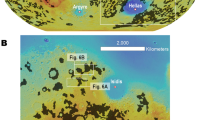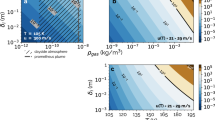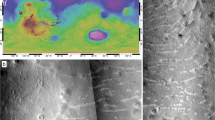Abstract
Arising from: P. A. Allen & P. F. Hoffman Nature 433, 123–127 (2005); Allen and Hoffman reply. Quantitative estimation of environmental properties using sedimentary structures preserved in rocks is complicated by the fact that some relationships between the fluid flow, sediment transport and bed topography are not unique. Allen and Hoffman1 propose that large, wave-generated sand ripples (orbital ripples) in Precambrian rocks were generated by sustained, extreme winds driven by rapid climate change after termination of the Marinoan glaciation. We show here that these features could equally well have formed under normal storm conditions in tens of metres of water. We therefore contend that the ripples do not provide direct evidence for a climatic transit after the break-up of a snowball-Earth's global ice cover.
Similar content being viewed by others
Main
Allen and Hoffman conclude that the observed ripples developed in deep water (depth h, 200–400 m), by waves of unusually large period (T, 21–30 s) and amplitude (H, 7.5–12 m). They suggest that a discrete cyclone or hurricane is likely to be too short-lived an event to produce the observed sedimentary structures and that present-day orbital ripples seldom have wavelengths (λ) exceeding 1 m, both of which we contest.
A bathymetric survey2 of the continental shelf off North Carolina in the United States found ripples with wavelengths of up to 4 m and a median grain diameter (D) of 0.1–5 mm covering the shelf at h values of 20–40 m. Field observations link formation of these ripples to specific hurricanes and tropical storms. Measured values of T and H for the water waves developed during these events commonly exceeded 60 s and 3 m, respectively. Detection of this bed topography seems to be limited by instrument resolution, rather than by a paucity of these features on the sea floor2.
Critical shear stress (ψc) for the initial motion of a particle of size D provides a minimum bed-stress condition for ripple formation1,2,3. An upper limit for bed stress associated with steep orbital ripples is 3ψc (ref. 2). This narrow range in bed shear stress plus the mean value for λ constrain the associated near-bed flow field2,3 (Fig. 1). With these parameters, T is the only surface-wave property that can be estimated from sedimentary deposits1,3. Airy wave theory relates wavelength (L), H and h to near-bed flow conditions1,3; however, an infinite combination of these variables can produce the same near-bed conditions (Fig. 1). Allen and Hoffman only consider transport conditions at ψ=ψc, which yields a maximum estimate for T. For ψ=3ψc, T is reduced by a factor of √(1/3) (Fig. 1). Flanks of some preserved ripples exceed the angle of repose, indicating deformation and making the measured steepness values inexact.
a, b, Calculations using Airy theory2,3 with a, T=30 s, ψ=ψc, and b, T=17 s, ψ=3ψc, where T is the wave period and ψ (ψc) is the (critical) shear stress. Ranges of wave conditions associated with reported water depths from refs 1 and 2 are indicated by grey boxes. For the figure, we used wavelength λ=3.5 m and ψc estimated from grain size D=0.12 mm (for methods, see ref. 2). Using entire ranges of D (0.12–0.5 mm) and λ (1.5–5.4 m) reported by Allen and Hoffman, and ψc⩽ψ⩽3ψc (ref. 2), yields T values of 8–41 s. We calculated the aggradation rate as r=m/T, where m=0.40 cm is the mean cross-bed thickness in Fig. 2c of ref. 1. When T is between 8 and 41 s, r is 0.58–2.99 cm min−1.
More important, Allen and Hoffman assume, without justification, that wind of unlimited fetch and duration generated the long-period surface waves producing the bedforms. Their estimates for H are based on this model and these values, in turn, are used to calculate h. Their environmental reconstruction represents a possible, but non-unique, inversion of the geological data. Modern storm-generated waves of similar period produce orbital ripples of the same morphology and grain size2 as the Marinoan examples, but under conditions of much smaller h, H and L. An independent constraint on any one of these three variables is necessary for closure. The most reasonable procedure would be to estimate water depth based on the physiographical position of ripples found within the ancient basin.
Perhaps the most remarkable aspect of the reported stratigraphy1 is the continuous vertical climb of the ripples. A rate of deposition associated with this climb is tightly constrained by T, and is calculated to be about 1 cm min−1. This high rate seems to rule out spontaneously precipitating carbonate4 as the sediment source for the ripples. At this rate, the entire sequence shown in Fig. 3 of ref. 1 could have been deposited in less than 3 h. A small number of short-duration events do not place any constraint on associated climate conditions.
Our results (Fig. 1) show that the preserved orbital ripples1 could have formed under rather mundane environmental conditions2, and therefore do not provide evidence for extreme climate change. We wish to make clear that our analysis does not address larger issues of the snowball-Earth hypothesis4, but rather serves to show that small-scale observations must be carefully placed within a basin-scale context to produce a unique set of environmental conditions associated with the accumulation of the observed sedimentary deposits.
References
Allen, P. A. & Hoffman, P. F. Nature 433, 123–127 (2005).
Ardhuin, F. et al. J. Geophys. Res. 107, 3143 (2002).
Komar, P. D. & Miller, M. C. J. Sedim. Petrol. 43, 1101–1110 (1973).
Hoffman, P. F. et al. Science 281, 1342–1346 (1998).
Author information
Authors and Affiliations
Corresponding author
Rights and permissions
About this article
Cite this article
Jerolmack, D., Mohrig, D. Formation of Precambrian sediment ripples. Nature 436, E1 (2005). https://doi.org/10.1038/nature04025
Published:
Issue Date:
DOI: https://doi.org/10.1038/nature04025
Comments
By submitting a comment you agree to abide by our Terms and Community Guidelines. If you find something abusive or that does not comply with our terms or guidelines please flag it as inappropriate.




